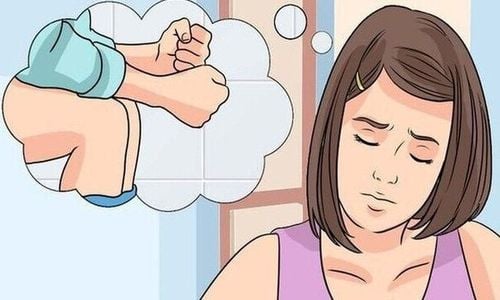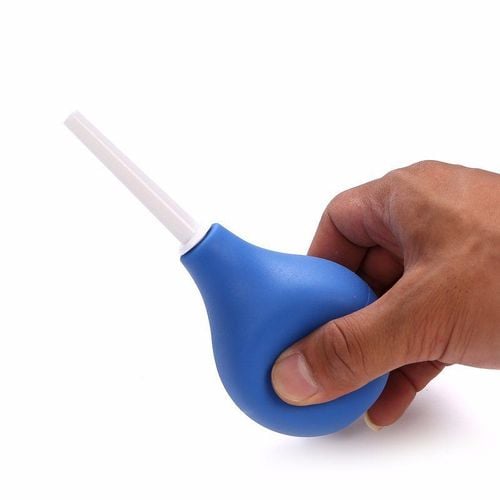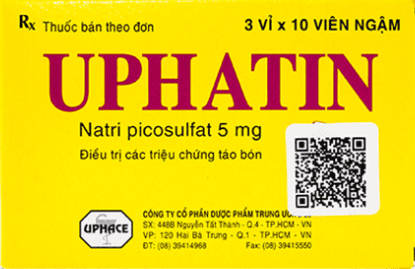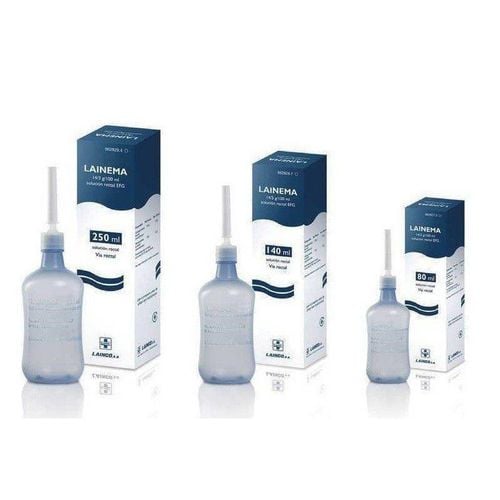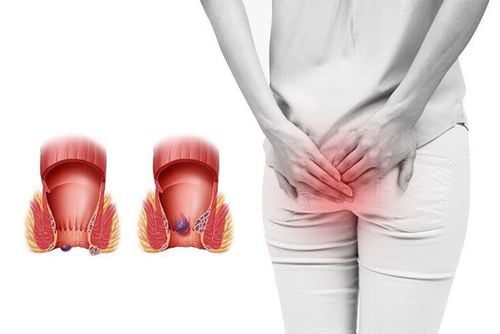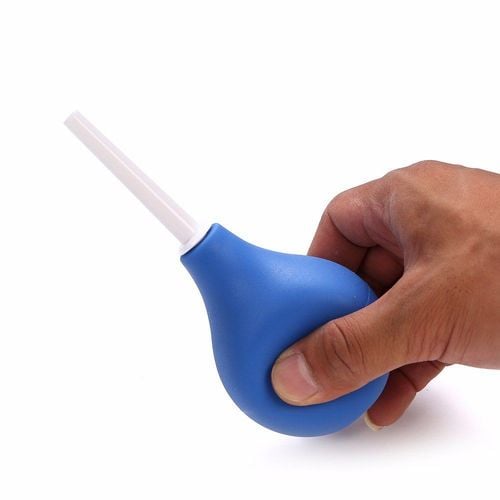This is an automatically translated article.
The article is professionally consulted with Master, Doctor Phan Ngoc Hai - Department of Pediatrics - Neonatology - Vinmec International General Hospital Da Nang. Dr. Hai used to work at Da Nang Obstetrics and Gynecology Hospital and Hoan My Da Nang General Hospital. His strength is in general pediatric examination and treatment, neonatal examination and treatment, and pediatric resuscitation.An enema for children is a procedure performed by inserting a small amount of fluid through the rectum into the colon to treat constipation or to support other diagnostic and therapeutic methods. Performing enema properly helps to reduce pain and discomfort for children and better support doctors in diagnosing and treating diseases.
1. Purpose of enemas for babies and children
Soften stools, support bowel movements; Stimulate the intestinal wall to expand and increase contraction to excrete feces; Cleanse the colon and rectum in acute fecal stasis; Be well prepared for diagnostic tests or pre-surgery.Trắc nghiệm: các chỉ số cần chú ý về sự phát triển thể chất của trẻ
Chiều cao, cân nặng của bé ở từng giai đoạn nên là bao nhiêu là bình thường, bao nhiêu là bất thường? Cùng ThS.BS Ma Văn Thấm điểm lại xem bạn đã nắm được các chỉ số phát triển thể chất của bé chưa nhé!The following content is prepared under supervision of Thạc sĩ, Bác sĩ y khoa, Ma Văn Thấm , Nhi , Phòng khám Đa khoa Quốc tế Vinmec Dương Đông(Phú Quốc)
2. Indications and contraindications for enema
2.1 Indications to perform Constipation patients ; Patients with Hirschsprung's disease (congenital hypertrophy or congenital colonic anastomosis; Before: Lower gastrointestinal endoscopy; Abdominal surgery: Biliary cyst or mesenteric cyst; X-ray: Colonic frame) Contrast-enhanced colon, UIV, retrograde bladder; Surgery: Anal fistula; Anal fistula of vestibular fossa; Para-anal residual flesh; Anal correction; Hirschsprung's disease; Temporary anal closure 2.2 Real contraindications Present Unexplained abdominal pain Typhoid; Intestinal obstruction – severe enteritis; Abnormal bleeding or thrombocytopenia; Recent rectal or colon surgery.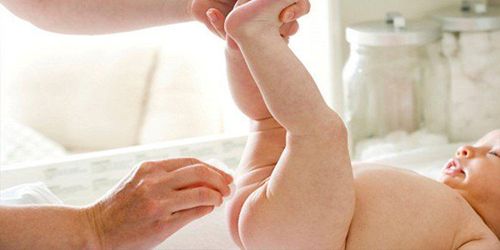
3. Solutions used in neonatal enema
Hypotonic or isotonic solution: Large fluid intake; Hypertonic solution: The amount of fluid introduced is small; Oily substance: For the purpose of lubricating stone stools and intestinal mucosa to make stools easier to pass; Colon enema: Inserting a small amount of liquid into the colon, repeated several times to stimulate bowel movements, and aid in the expulsion of stool.4. Retractable positions for babies
Position 1: Place the patient in the left side position, with both knees facing up to the chest; Position 2: Have the patient lie on his back, legs raised and anus exposed (best position for infants); Position 3: For the patient to lie on the left side, the right thigh is bent about 45o relative to the body axis, lying close to the edge of the bed; Position 4: Also known as the pillow-chest position, ie the child is balanced with his knees, arms and head placed on a pillow so that the buttocks will create an upward angle compared to the bed, creating favorable conditions. convenient to perform indentation.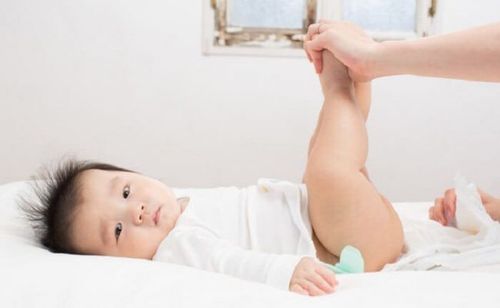
5. The length of the Sonde tube inserted into the anus and the amount of water drained
5.1 Length of Sonde tube inserted into the anus Infants under 10kg: 2.5 – 3.75cm; Children 10 – 30kg: 5cm; Older children 30 – 49.5kg: 7.5cm; Teenagers over 49.5kg: 10cm. 5.2 Amount of enemas Preterm infants: 5 – 20ml; Children under 1 year old: 50-100ml; Children under 2 years old: 100 – 150ml; Children from 2 to 6 years old: 180ml; Children from 6 to 12 years old: 360ml; Children over 12 years old: 480 ml.6. Instructions on how to indent for babies
6.1 Prepare necessary tools The tool tray includes: 0.9% physiological saline solution, temperature 37.8oC; bock; 1.5m - 2m rubber extension cord with lock; the size of the anal catheter depends on the age of the child; Water-soluble lubricants: K-Y; Pea tub; Gauze, smooth cloth, toilet paper, apron; Clean gloves; Suspension post; Sharps container, infectious waste container and general waste container. 6.2 Procedures for performing indentation for children Compare medical records to identify the patient, explain to the child (depending on age) and family members. For older children, encourage them to drink 1-2 glasses of water before enema; Wear masks, wash hands, prepare tools, wear aprons; Attach the extension cord, tie the cord to the bock, lock the cord; Check the water temperature, pour water into the bock, hang the bock on the hanging post, about 10cm above the anus of the patient; Place the patient in an appropriate position; Spread smooth cloth under the buttocks, cover the patient, expose the anal area; Put the pea tub in a convenient place, wash your hands and wear gloves; Attach the catheter to the connecting line, expel air, lubricate the catheter; Insert the catheter into the anus by: Draw the child's buttocks out, insert the tube into the anus in the anal-umbilical direction, the length of the tube inserted according to the age or weight of the child has been prescribed; Unlock the water to flow into the tube with low pressure, one hand holding the tube. At this time, medical staff need to closely observe the patient to detect strange symptoms in time: if the baby has abdominal pain, stop letting water flow in; if the baby has a lot of colic, lower the bock lower than the bed to reduce the water pressure, and at the same time encourage the child to relax, inhale deeply and exhale quickly; Check the water level in the bock, when the water is almost empty, lock the connection and remove the catheter from the patient's anus; Cleaning and drying for pediatric patients to rest; Clean tools, wash hands, instruct caregivers about letting the child stay in that position until the abdominal pain is severe (after about 2-5 minutes, remove the tube), let the baby sit on the potty for 15-30 minutes to dig. discharge all waste out; Recording: Including the solution used for enema, the amount of fluid in and out; the nature, color and quantity of stool; the child's reactions such as unusual abdominal pain, shock symptoms or unusual reactions.7. Unusual reactions of children after enema and how to handle them
Electrolyte disorders: There are manifestations of irritability, irritability. The cause of this phenomenon is due to the use of enemas with the wrong concentration. To treat, medical staff need to stop performing enema and notify the doctor. To prevent complications of electrolyte disorders, it is necessary to use physiological saline at the correct concentration of 0.9%; Hypothermia: Children have mild pale lips, cold hands and feet, shivering. This phenomenon comes from the cause of using the enemas solution at the wrong temperature when performing enema. The treatment is to dry, keep the child warm, monitor the child's temperature and notify the doctor if it worsens. To prevent complications, healthcare workers should use saline enemas at the correct temperature; Mucosal lesions: Manifestations are watery discharge with fresh blood or pink color. The cause of this condition is due to the medical staff using an inappropriately sized catheter, the intubation is not gentle, or the child is not cooperative. When experiencing this problem, the nurse should stop performing and immediately notify the doctor for an appropriate treatment plan. Measures to prevent the risk of mucosal damage is to use a suitable sized catheter, gently manipulate and guide the family to reassure the child so that the child can cooperate in the enema process; Intestinal perforation: The most serious complication of enemas in infants and young children. Children have symptoms of severe abdominal pain, rapid pulse, increased breathing rate, abdominal distension, fussiness, irritability. The cause of this complication is similar to the mucosal damage phenomenon, so there is a similar treatment and prevention method; The catheter slips into the intestinal lumen: Manifestation is the loss of the catheter. The cause of this phenomenon is that the medical staff placed the catheter too deeply and did not closely monitor the operation. When experiencing this problem, medical staff should immediately notify the doctor for a timely treatment plan. To prevent incidents, the nursing staff should pay attention not to insert the catheter too deeply and closely monitor the child's manipulation process.8. Note when indenting at home for children

For children, pumping liquid into the intestines will make them uncomfortable, they want to go to the toilet immediately. Therefore, parents need to soothe the baby, guide the baby to breathe deeply to reduce stress and delay the bowel movement for a few minutes to soften the stool and make it easier to defecate; When inserting enemas into the baby's rectum, parents can add a little lubricant to the tip of the tube to make it easier to insert. If still not able to enter, parents should not try too hard because it can tear the anal tissues, causing pain to the baby; Enemas are usually prescribed for children over 2 years old. For children under 2 years old, use enemas only when ordered by a doctor and should strictly follow the instructions for implementation; For children under 6 years of age, parents should carefully monitor the child's symptoms of constipation. If the baby has bowel movements less than 3 times a week but still plays well, sucks well and has no hard stools, there is no need to intervene with enemas or laxatives; Do not give enemas too often when your child is constipated because this will make him dependent on the medicine. Not only that, the frequent enema also makes the anus easily irritated and causes tissue damage; If your baby is constipated with symptoms such as nausea, vomiting, anal pain, swelling, etc., parents should take the child to the doctor immediately instead of doing enema at home to avoid the symptoms of the disease returning. should be more serious. Enema is an essential technique performed in the diagnosis and treatment of many different diseases. When children perform enemas, parents need to guide their children to coordinate well with medical staff to avoid the risk of unpredictable complications.
Please dial HOTLINE for more information or register for an appointment HERE. Download MyVinmec app to make appointments faster and to manage your bookings easily.






